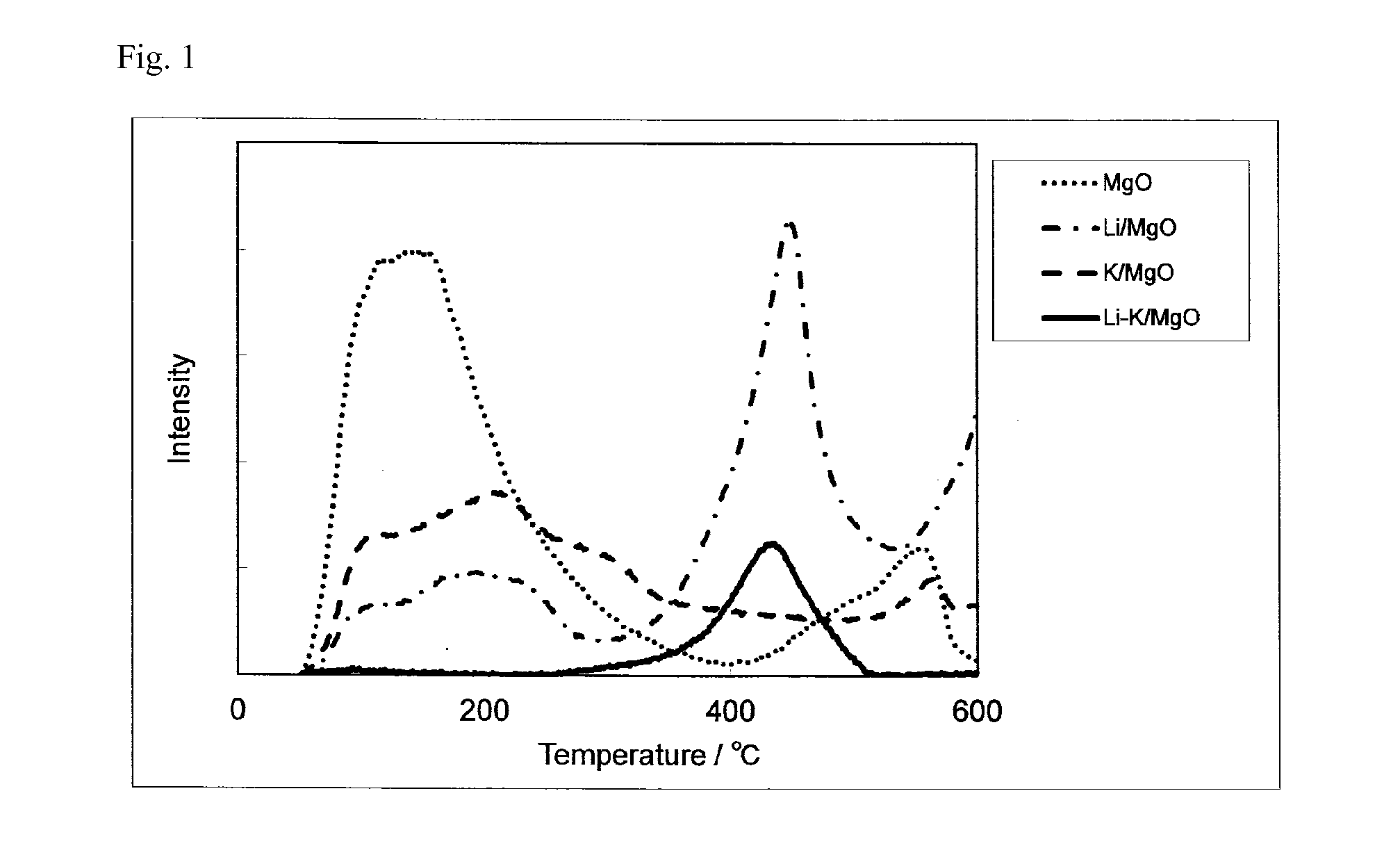Catalyst Mixture for Olefin Metathesis Reactions, Method of Producing Same, and Method of Producing Propylene Using Same
a technology of olefin metathesis and catalyst mixture, which is applied in the direction of physical/chemical process catalysts, bulk chemical production, metal/metal-oxide/metal-hydroxide catalysts, etc., can solve the problems of shortening the regeneration cycle, lowering the selectivity of catalysts, and lowering catalyst activity, so as to inhibit the activity of isomerization reactions and improve reaction activity. , the effect of high activity
- Summary
- Abstract
- Description
- Claims
- Application Information
AI Technical Summary
Benefits of technology
Problems solved by technology
Method used
Image
Examples
example 1
[0052]An aqueous solution prepared by dissolving 9.95 g of lithium nitrate and 3.73 g of sodium nitrate in 20 mL of water was supported on 100 g of tablet-shaped magnesium oxide, wherein the amount of lithium and sodium metals supported was each equivalent to 1% by weight. The resultant was dried at 110° C. for one hour and then baked at 600° C. in the air for two hours, thereby obtaining composite co-catalyst 6. This co-catalyst in an amount of 7.5 mL and 22.5 mL of WO3 / SiO2 catalyst were mixed and then filled in a reactor. A test was carried out according to the performance evaluation method. As a result, the t-2-butene conversion ratio and propylene selectivity at 350° C. in regard to the mixed catalyst for an olefin metathesis reaction using the composite co-catalyst 6 were 49% and 97%, respectively; and the t-2-butene conversion ratio and propylene selectivity at 450° C. were 73% and 97%.
example 2
[0053]An aqueous solution prepared by dissolving 9.95 g of lithium nitrate and 2.61 g of potassium nitrate, and 100 g of tablet-shaped magnesium oxide were treated by the same procedures as described in Example 1, thereby obtaining composite co-catalyst 7, wherein the amount of lithium and potassium metals supported was each equivalent to 1% by weight. When this was subjected to the performance test by the same procedures as described in Example 1, the t-2-butene conversion ratio and propylene selectivity at 350° C. in regard to the mixed catalyst for an olefin metathesis reaction using the composite co-catalyst 7 were 74% and 95%, respectively; and the t-2-butene conversion ratio and propylene selectivity at 450° C. were 78% and 96%. Further, the t-2-butene conversion ratio and propylene selectivity at 300° C. were 58% and 97%.
example 3
[0054]An aqueous solution prepared by dissolving 9.95 g of lithium nitrate and 1.74 g of rubidium nitrate, and 100 g of tablet-shaped magnesium oxide catalyst were treated by the same procedures as described in Example 1, thereby obtaining composite co-catalyst 8, wherein the amount of lithium and rubidium metals supported was each equivalent to 1% by weight. When this was subjected to the performance test by the same procedures as described in Example 1, the t-2-butene conversion ratio and propylene selectivity at 350° C. in regard to the mixed catalyst for an olefin metathesis reaction using the composite co-catalyst 8 were 46% and 94%, respectively; and the t-2-butene conversion ratio and propylene selectivity at 450° C. were 75% and 94%.
PUM
| Property | Measurement | Unit |
|---|---|---|
| Temperature | aaaaa | aaaaa |
| Percent by mass | aaaaa | aaaaa |
| Weight | aaaaa | aaaaa |
Abstract
Description
Claims
Application Information
 Login to View More
Login to View More - R&D
- Intellectual Property
- Life Sciences
- Materials
- Tech Scout
- Unparalleled Data Quality
- Higher Quality Content
- 60% Fewer Hallucinations
Browse by: Latest US Patents, China's latest patents, Technical Efficacy Thesaurus, Application Domain, Technology Topic, Popular Technical Reports.
© 2025 PatSnap. All rights reserved.Legal|Privacy policy|Modern Slavery Act Transparency Statement|Sitemap|About US| Contact US: help@patsnap.com


